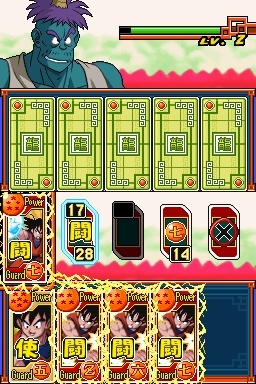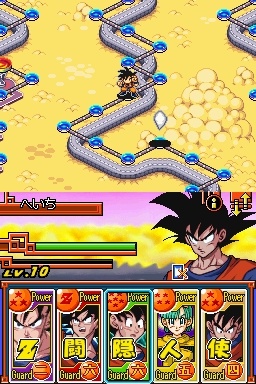A big part of the niche appeal of card-battle video games can be attributed to their relative complexity. Unfortunately, this complexity also tends to alienate the majority of players. And that these games often assume familiarity with real-world collectible card games doesn't help matters, either. Dragon Ball Z: Harukanaru Densetsu attempts to address this by offering a simplified card-battling system and couching it in a story mode that makes the whole experience more accessible. In the process, though, the game loses much of the strategizing that makes card battling fun.

Dragon Ball Z: Harukanaru Densetsu is essentially like the old playing-card game War--two players draw cards against each other, and the player with the higher card wins--except with a few layers of nonsense piled on top. During a battle, each combatant has a five-card hand--no more, no less. Every card has three defining characteristics--power value, guard value, and action type. The power and guard values simply determine that card's offensive and defensive levels, while the action type determines what the card actually does. There are eight different types of actions, including a straightforward attack action, the ability to raise the power and guard values of the cards currently in your hand, the ability to swap cards with your enemy, and more.
Playing a card is simple, since you don't have to worry about card placement or tapping mana points or anything like that. Just select a card from your hand, and your opponent will do the same. Whichever card has a higher power value will generally win, at which point the difference between the winning card's power value and the losing card's guard value will determine how much damage the loser takes. This goes back and forth, with a new card from your imaginary deck taking the place in your hand of any cards that have been played, until one combatant's life bar is depleted. It's terribly easy to pick up, and the game offers a painstakingly detailed tutorial to make sure everything is crystal clear. The problem is that by stripping out elements like card placement and tapping mana points, luck becomes a much greater factor. Since the power value of the card you're playing all but determines whether the card will have any positive impact for you, it's mostly a matter of luck as to whether the card you play will outrank your opponent's. Not to belabor the point, but it really does feel an awful lot like War.
There are card combos to consider that potentially make the action more involved and, hence, more interesting. If you have multiple cards in your hand with the same power or guard value, you can play them at once, adding up whatever the common value is. It still mostly comes down to whether you've got good cards in your hand, but it's useful if you've got lousy cards that you just need to get rid of. It's just too bad that the story mode takes its sweet time introducing card combos. You'll probably be a good four hours or so into the game before guard combos are even introduced.
The story mode, which sleepwalks through the same, tired Dragon Ball Z story arcs that have been used to prop up countless other DBZ games, adds another layer to the action by having you seek out your enemies on a map screen in a series of separate scenarios. The same hand of cards you use in the card battling are used here as well, with the power value of the card you play during a given turn determining how many spaces you'll move and the guard value determining whether you'll be able to avoid engaging in a random-encounter card battle. The goal in any particular scenario is usually just to chase down and beat up any number of opponents, though there's also plenty of meaningless wandering around that's seemingly designed to force you into more random-encounter card battles.

What's most exasperating about the scenarios is that after you've spent a bunch of time toiling about the map and getting into a series of relatively easy card battles, the process will usually culminate in a battle against a foe that's significantly more powerful than any of the enemies you've faced up to that point. If you lose this card battle, you'll have to start that scenario from scratch. With an average scenario lasting about a half-hour, the prospect of having to go through all that tedium just for an opportunity to advance to the next scenario is a grim one. That you'll be subjected to the same looping battle music and repetitive 2D animations doesn't help matters.
There are some multiplayer options, but it's no more fun to play the game against live local opponents than it is against the computer. Points should be given to Dragon Ball Z: Harukanaru Densetsu for trying something that doesn't just feel like a palette-swapped Yu-Gi-Oh! game. It's certainly something different, but it lacks the necessary strategy elements that actually make card-battling games fun.